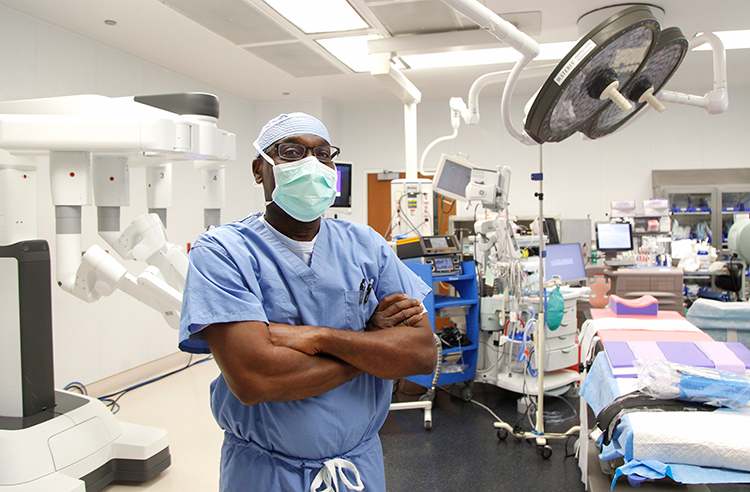
Imagine what you could do with two extra arms. Well, advanced technology in the medical profession has actually achieved that expanded capability through robotic-assisted surgeries.
Highly skilled and trained surgeons are utilizing the four arms of a robot to perform a multitude of minimally invasive surgeries with precision that can’t be duplicated in open surgery.
Dr. George Fyffe, a gynecological surgeon with Cleveland Clinic Indian River Hospital, uses robotic surgery to perform minimally invasive, laparoscopic hysterectomies.
During his robotic-assisted surgeries, a thin, lighted tube with a camera on the end is inserted into the abdomen through a small incision. The image is sent to a video screen in magnified, high-definition 3D, giving the surgeon a clear view of the abdomen. The camera is also steadier than a handheld camera.
“In robotic surgery we connect the camera to one of the arms of the robot which allows us to operate as if we had our hands in there,” said Dr. Fyffe. “It gives us more dexterity and a better view, so we are able to manipulate specimens that we are operating on. The robot has four arms to which we attach tiny instruments. The arms are ‘wristed’ and move like a human hand but with a far greater range of motion.
“The surgeon sits at the console a gives commands to the laparoscopic instrument instructing it to move left, right, up, down, across and in between. Robotic-assisted surgery allows us to move our hands and instruments with six degrees of freedom in terms of movement as opposed to open surgery that only allows us three degrees of freedom. Not only do we have more arms to work with, but we have greater dexterity in those arms than we do with our own hands. We are also able to manipulate the instruments and move the tips of them in different ways. Regular laparoscopic instruments don’t allow that.”
During the procedure, in most cases, there is a doctor at the console and a doctor by the patient; however, the procedures can be done with a surgical assistant. Procedures requiring general anesthesia will also have an anesthesiologist at the patient’s head checking their vital signs continuously.
“The benefits of robotic assisted surgery are less blood loss, less time in the hospital, smaller incisions and a much quicker recovery time,” Dr. Fyffe explained. “A robotic-assisted hysterectomy can be performed in the morning and the patient can be sent home later that evening, alleviating the need for overnight hospitalization. And the patient can go back to their normal routine after about 10 days. The robot gives us four arms to work with instead of two making the procedure more precise, and since it’s minimally invasive it keeps the patient out of the hospital.”
Robotic-assisted surgery may not be for everyone, however.
During the procedure, the patient’s head is tilted back and the feet upwards. A patient who can’t take on a supine position because of a prior medical condition would not be a good candidate for a robotic procedure.
Testing is done in the operating room prior to the surgery to establish whether the patient can safely tolerate an inverted position for about two hours. In some cases, the procedure may start as a robotic assisted surgery but convert to open surgery due to bleeding or other complications.
But at Indian River Hospital the conversion rate from robotic to open surgery is 2 percent or less.
“Not all surgeons are trained for robotic assisted surgery,” Dr. Fyffe said. “There is a very steep learning curve. The surgeons must first go to an animal lab, then a robotic lab, complete a series of modules and then they are ready to start being proctored by an experienced robotic surgeon.
“My proctor was my chief resident in medical school. He flew down to Indian River Hospital and proctored me on five cases before he signed me off and I was able to do the procedures on my own. I’ve been robotic assisted laparoscopic surgeries since 2012.”
Besides hysterectomies, other common reasons for undergoing robotic assisted gynecologic procedures include, the diagnosis and treatment of endometriosis, chronic pelvic pain, pelvic inflammatory disease, myomectomy and causes of infertility.
A reproductive entomologist can use robotic assisted surgery to reverse a tubal ligation by going in and opening up the ends of the tubes and rejoining them. Robotic-assisted surgery is also used for the removal of fibroids, uterus, ovarian cysts and ectopic pregnancy.
Dr. George Fyffe completed his residency at Bronx-Lebanon Hospital Center in New York and has been with Cleveland Clinic Indian River Hospital for nearly 16 years. Prior to joining Indian River Hospital, Dr. Fyffe was affiliated with Jackson North Medical Center in North Miami Beach, Florida; Archbold Medical Center in Cairo, Georgia; and North Shore Medical Center in Miami. He can be reached at his practice at Cleveland Clinic Indian River Partners in Women’s Health, 1050 37th Place, Suite 101, Vero Beach, 772-770-6116.



